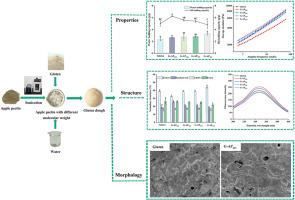Changes of physicochemical and structural properties of wheat gluten induced by apple pectin with different molecular weights
IF 11
1区 农林科学
Q1 CHEMISTRY, APPLIED
引用次数: 0
Abstract
In this study, apple pectin (AP) was first subjected to ultrasonic degradation to obtain four kinds of pectins (AP518, AP384, AP335 and AP297) with different molecular weights (Mw). Subsequently, the structure-activity relationship between the Mw of AP and the impact of AP on gluten characteristics and network structure was investigated. The result indicated that AP and gluten protein mainly interacted through hydrogen bonds, thus changing the gluten characteristics and network structure. Notely, the changes of gluten properties and network were closely related to the Mw of AP. Specifically, low-Mw AP enhanced the water holding capacity and rheological properties of gluten protein. Compared with the control group, AP297 significantly increased the surface hydrophobicity of gluten protein from 86.19 to 105.33, while decreasing the fluorescence intensity of gluten protein from 224.17 to 200.23. The result indicated that AP297 was more likely to interact with gluten protein and form protein aggregates. Meanwhile, compared with AP518, AP297 significantly increased the enthalpy (from 120.83 J/g to 164.82 J/g), β-sheet content (from 32.52 % to 44.28 %), and disulfide bonds content (from 15.67 μmol/g to 19.38 μmol/g) of gluten protein. These above results suggested that the network structure of gluten protein was improved and became more stable. In addition, SEM also further confirmed that AP297 could better maintain the gluten network structure. These findings can be said to offer theoretical support for the rational application of AP with varying Mw in wheat flour products.

不同分子量苹果果胶对小麦面筋理化及结构特性的影响
本研究首先对苹果果胶(AP)进行超声波降解,得到4种不同分子量(Mw)的果胶(AP518、AP384、AP335和AP297)。随后,研究了AP分子量与AP对面筋特性和网络结构的影响之间的构效关系。结果表明,AP与面筋蛋白主要通过氢键相互作用,从而改变了面筋特性和网络结构。值得注意的是,面筋性质和网络的变化与AP的Mw密切相关。具体而言,低Mw的AP增强了面筋蛋白的持水能力和流变性能。与对照组相比,AP297显著提高了面筋蛋白的表面疏水性,从86.19提高到105.33,同时使面筋蛋白的荧光强度从224.17降低到200.23。结果表明,AP297更容易与面筋蛋白相互作用,形成蛋白聚集体。与AP518相比,AP297显著提高了面筋蛋白的焓(由120.83 J/g提高到164.82 J/g)、β-sheet含量(由32.52%提高到44.28%)和二硫键含量(由15.67 μmol/g提高到19.38 μmol/g)。上述结果表明,面筋蛋白的网络结构得到改善,变得更加稳定。此外,SEM也进一步证实AP297能更好地维持面筋网络结构。研究结果可为不同分子量AP在小麦粉制品中的合理应用提供理论支持。
本文章由计算机程序翻译,如有差异,请以英文原文为准。
求助全文
约1分钟内获得全文
求助全文
来源期刊

Food Hydrocolloids
工程技术-食品科技
CiteScore
19.90
自引率
14.00%
发文量
871
审稿时长
37 days
期刊介绍:
Food Hydrocolloids publishes original and innovative research focused on the characterization, functional properties, and applications of hydrocolloid materials used in food products. These hydrocolloids, defined as polysaccharides and proteins of commercial importance, are added to control aspects such as texture, stability, rheology, and sensory properties. The research's primary emphasis should be on the hydrocolloids themselves, with thorough descriptions of their source, nature, and physicochemical characteristics. Manuscripts are expected to clearly outline specific aims and objectives, include a fundamental discussion of research findings at the molecular level, and address the significance of the results. Studies on hydrocolloids in complex formulations should concentrate on their overall properties and mechanisms of action, while simple formulation development studies may not be considered for publication.
The main areas of interest are:
-Chemical and physicochemical characterisation
Thermal properties including glass transitions and conformational changes-
Rheological properties including viscosity, viscoelastic properties and gelation behaviour-
The influence on organoleptic properties-
Interfacial properties including stabilisation of dispersions, emulsions and foams-
Film forming properties with application to edible films and active packaging-
Encapsulation and controlled release of active compounds-
The influence on health including their role as dietary fibre-
Manipulation of hydrocolloid structure and functionality through chemical, biochemical and physical processes-
New hydrocolloids and hydrocolloid sources of commercial potential.
The Journal also publishes Review articles that provide an overview of the latest developments in topics of specific interest to researchers in this field of activity.
 求助内容:
求助内容: 应助结果提醒方式:
应助结果提醒方式:


